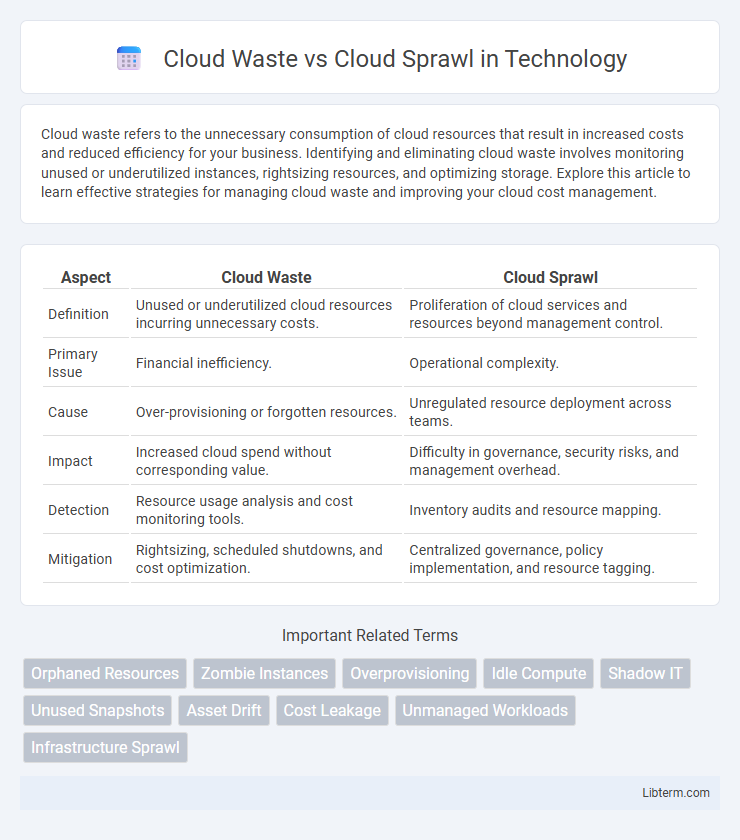Cloud waste refers to the unnecessary consumption of cloud resources that result in increased costs and reduced efficiency for your business. Identifying and eliminating cloud waste involves monitoring unused or underutilized instances, rightsizing resources, and optimizing storage. Explore this article to learn effective strategies for managing cloud waste and improving your cloud cost management.
Table of Comparison
| Aspect | Cloud Waste | Cloud Sprawl |
|---|---|---|
| Definition | Unused or underutilized cloud resources incurring unnecessary costs. | Proliferation of cloud services and resources beyond management control. |
| Primary Issue | Financial inefficiency. | Operational complexity. |
| Cause | Over-provisioning or forgotten resources. | Unregulated resource deployment across teams. |
| Impact | Increased cloud spend without corresponding value. | Difficulty in governance, security risks, and management overhead. |
| Detection | Resource usage analysis and cost monitoring tools. | Inventory audits and resource mapping. |
| Mitigation | Rightsizing, scheduled shutdowns, and cost optimization. | Centralized governance, policy implementation, and resource tagging. |
Understanding Cloud Waste
Cloud waste refers to the unnecessary expenditure and inefficient use of cloud resources, often resulting from overprovisioning, idle instances, or unused storage. Understanding cloud waste involves identifying underutilized virtual machines, orphaned storage, and ineffective cost management practices that inflate cloud bills. Addressing cloud waste requires continuous monitoring, right-sizing resources, and implementing automation for optimized cloud cost control.
Defining Cloud Sprawl
Cloud sprawl refers to the uncontrolled proliferation of cloud resources across multiple environments, accounts, or subscriptions, leading to complexity and inefficiency. It occurs when organizations deploy cloud services without proper governance or oversight, causing redundant, underutilized, or orphaned resources. This unmanaged expansion drives up costs and complicates security management, contrasting with cloud waste, which specifically highlights financial inefficiencies in cloud spending.
Key Differences: Cloud Waste vs Cloud Sprawl
Cloud waste refers to the inefficient use of cloud resources, leading to unnecessary costs due to underutilized or idle services, whereas cloud sprawl describes the uncontrolled proliferation of cloud instances and services across an organization without proper governance. The key difference lies in cloud waste being a cost management issue, while cloud sprawl primarily concerns governance and operational complexity. Addressing cloud sprawl helps prevent cloud waste by enforcing policies, budgeting, and resource tracking to optimize cloud expenditures.
Causes of Cloud Waste
Cloud waste primarily stems from unused or underutilized resources such as idle virtual machines, oversized storage, and redundant services, often exacerbated by poor monitoring and lack of governance. Misconfigured auto-scaling policies and inefficient instance type selection contribute significantly to unnecessary cloud expenses. Organizations that fail to enforce resource optimization and lifecycle management encounter increased cloud waste despite the dynamic nature of cloud environments.
Drivers Behind Cloud Sprawl
Cloud sprawl refers to the uncontrolled proliferation of cloud resources across multiple platforms, driven primarily by decentralized decision-making, lack of oversight, and the ease of provisioning new services. Key drivers include organizational silos requesting cloud assets independently, inadequate governance policies, and the rapid adoption of multi-cloud strategies without centralized cost and usage monitoring. This uncontrolled growth complicates cost management and resource optimization, leading to increased cloud waste through underutilized or redundant services.
Impact on Cloud Cost Management
Cloud waste results from underutilized or idle resources, leading to unnecessary expenses and inefficient budget allocation in cloud cost management. Cloud sprawl occurs when uncontrolled provisioning of cloud services generates fragmented, overlapping resources, complicating cost tracking and optimization efforts. Both phenomena significantly inflate cloud expenditures, making comprehensive monitoring and governance essential for effective cost control.
Strategies to Reduce Cloud Waste
Implementing automated monitoring tools and regular cost audits effectively reduce cloud waste by identifying idle or underutilized resources. Rightsizing instances based on workload demand ensures optimal performance while minimizing unnecessary expenses. Encouraging governance policies, such as enforcing tagging standards and resource lifecycle management, prevents cloud sprawl by maintaining organized and accountable cloud environments.
Prevention Techniques for Cloud Sprawl
Implementing strict governance policies and continuous cloud cost monitoring tools effectively prevent cloud sprawl by controlling resource provisioning and usage. Automating resource lifecycle management, including regular audits and decommissioning of unused assets, reduces redundant cloud services and optimizes expenditure. Establishing centralized cloud management platforms enhances visibility and enforces compliance, minimizing the risk of unchecked expansion and inefficient cloud utilization.
Role of Governance in Cloud Resource Optimization
Effective governance plays a crucial role in mitigating cloud waste by implementing clear policies and automated controls to monitor resource allocation and usage. By establishing accountability frameworks and continuous cost analysis, governance prevents cloud sprawl, which results from uncontrolled provisioning and idle resources. Optimized cloud governance ensures sustainable cloud resource management, reduces unnecessary expenditure, and aligns cloud consumption with organizational goals.
Future Trends in Cloud Infrastructure Management
Future trends in cloud infrastructure management address the growing challenge of cloud waste--unnecessary or underutilized resources leading to increased costs--by employing advanced AI-driven analytics and automated resource optimization tools. Cloud sprawl, characterized by uncontrolled expansion of cloud services and accounts, is increasingly managed through centralized governance frameworks and multi-cloud management platforms that ensure consistent policy enforcement and cost control. Emphasis on predictive resource allocation and integration of FinOps practices are key strategies to combat both cloud waste and sprawl, driving efficiency and sustainability in evolving cloud environments.
Cloud Waste Infographic

 libterm.com
libterm.com